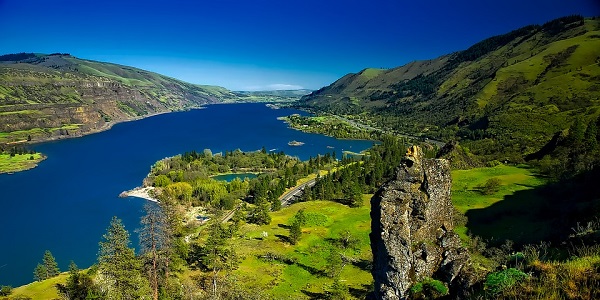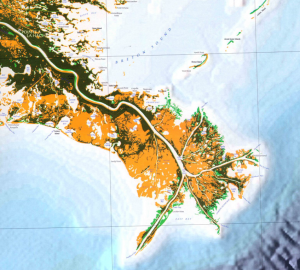
August 7, 2017, by lgzsam1
Restoring the Dignity of Rivers
In this blog, Professor Colin Thorne shares with us his ‘restoring the dignity of rivers’ speech from the River Restoration Northwest Speaker Series given in Seattle, 23 May 2017.
‘everything has either a price or a dignity. Anything that has a price can be replaced by something else as its equivalent, but anything that is above all price, and therefore admits of no equivalent, has a dignity.’ – Immanuel Kant (1781) [1]
Introduction
Rivers are important natural resources that can be used to help meet the needs of society by providing a wide range of different benefits. But some of these benefits are more highly valued than others, and it is the highly valued benefits of the river that are the most sought after.
For example, when the Columbia River Treaty was negotiated in the 1950s and early-1960s, the US and Canada focused on building dams to maximise the river’s capacity to generate income (from hydro-electric power) and minimise its potential to generate costs (due to flooding). Though the effect of the dams in blocking salmon passage was understood, it was thought at the time that the loss of a fishery was a price worth paying for those benefits. In any case, the theory was that the fishery could be maintained, at least in part, by replacing wild salmon with hatchery fish.
In these terms and at that time, wild salmon had a price but not dignity because the natural fishery could be replaced by something else as its equivalent – in this case, hatchery salmon.
Similarly, in the Lower Mississippi River, navigation and flood control functions have long been prioritised and the river has been managed to optimise those functions using tributary reservoirs, flood diversion channels, and thousands of miles of levees, bank revetments, and low dikes.
The engineering works have been hugely expensive, but a benefit to cost ratio of 37:1 suggests that the investment has been well worth making. While the USGS and USACE were aware that sediment loads in the LMR were declining throughout the second half of the twentieth century, at least in part due to dam building and river training, reduced sediment supply to the delta was deemed to be a problem that could be solved using further river and coastal engineering to protect key infrastructure including the navigation channel, petro-chemical refineries and population centres. In these terms, there was a price attached to losing delta land more generally, but one that was deemed to be worth paying.
Belize Lobe of the Mississippi Delta, orange shaded area shows land area lost up to 2005. [2]
In the event, Louisiana has lost approaching 2,000 square miles of land and the delta is eroding at a rate of one football field per hour. It is only now that the navigation channel is starting to be compromised by disappearance of the delta that serious consideration is being given to trying save it.
It’s going to cost billions of dollars to save the Mississippi Delta and its ecosystem, and in the Columbia Basin, hundreds of millions of dollars are spent annually in attempting to save listed salmon from extinction. So how were these problems allowed to happen in the first place and why have they been allowed to persist and worsen for so long?
The Value of Rivers
These problems stem from society placing different economic values on the benefits provided by different river functions and losing sight of the fact that there are many societal needs and river functions but only one river. Deciding which river function is the most important is like asking a parent which of their children they like the best. There is no correct answer – or at least there shouldn’t be. All a river’s natural functions are important – no part of it is superfluous.
If one river function is favoured and artificially enhanced, the others are adversely impacted. Through time, the functionality of the river deteriorates: undervalued functions degrade and unvalued ones are lost entirely but, usually, nobody cares or even notices until valued functions and the benefits they provide start to go south as well – which they always do as the river starts to unravel morphologically, and/or the water quality deteriorates, and aquatic, riparian and floodplain ecosystems begin to collapse.
I trace the root cause of this flawed approach to river management to the gulf that exists between Economics and Ecology – at least in More Economically Developed Countries (MEDCs): yet Ecology and Economy differ only in their suffixes and I’ve always wondered about that. These words share the common root oikos, from the Greek for ‘house’.
Historically then, Ecology and Economy were not in conflict. Ecology, is the study of the “house” including counting and understanding its inhabitants and its resources. Ecology, then informs the actions of the Economist; the thrifty steward who manages the household and distributes its resources, according to principles of Economy.
But since the industrial revolution, theories and practices of Ecology and Economy at least in MEDCs have diverged and they are now disconnected to the point of being regarded as being at opposite ends of a spectrum of human interests; that Ecology may be a luxury we can’t afford, that Ecology can and may have to be sacrificed on the altar of development. i.e. the argument that environmental regulation that protects Ecology, constrains industrial enterprise and damages the Economy.
When we remind ourselves of the original meaning of Economy and real relationship between Ecology and Economy, the fallacy of the argument becomes clear. Essentially, Ecology is the traditional and proper context of Economy and not the other way round. Economy is the application the active use of Ecology to meet the needs of the people judiciously and within the limits set by Ecology in its broadest sense – which includes the household’s water, land, minerals, plants and animals.
The reality is now rather different. This is captured in Bill Clinton’s memorable catch phrase from the 1992 presidential campaign:
What has happened is that Ecology has become part of the Economy – we even refer to there being a ‘Green Economy’ and use concepts like Ecosystem Services to value ecosystem benefits – true, ecological bean counting.
We have lost the plot – Ecology isn’t part of Economics – Economics is part of Ecology. When and where Ecology is treated as part of the Economy, the Economy consumes the Ecology.
This started at an industrial scale in Europe with the agricultural and industrial revolutions of the 18th and 19th centuries and, as MEDCs exhausted their own Ecologies during the 19th and 20th centuries, they consumed the Ecologies of other nations through colonisation and over-exploitation, latterly through multi-national corporations. The process continues during the 21st century as part of globalisation.
For this to stop we need to put Economics back into its rightful place as the judicious use of Ecology – the sustainable development and prudent use of the planet’s natural and human resources through sound application of the best science and by employing new, low carbon technologies.
So next time somebody tells you it’s the economy, stupid – point out that, actually, it’s the ecology, stupid.
The Dignity of Rivers
Which leads me back to why we should restore the Dignity of rivers and why it is now more important than ever that we do so quickly, for one simple reason: the future of the rivers we restore today is not going to be the same as their past or even their present.
The fact is that the future is not uncertain, it is unknowable and anyway the one really good thing about the future is that if we foresee a future that we don’t like, we can change it; though only if we make the right choices and take the necessary actions at the right times.
We don’t know how the demands we place on rivers will change as our society and Economy develops, we don’t know how land use will change as communities grow and evolve, and we don’t know how the river will respond as climate changes.
Hence, we can’t design restored rivers to be fit for future conditions, because we don’t know and can’t know the correct design parameters. So we have to do something different.
We have to recall that natural rivers and their ecosystems are not designed – they evolve. They always have, always will and always must, because as Charles Darwin pointed out:
‘It is not the strongest of the species that survives, nor the most intelligent, but the one most responsive to change.’
What we (as river restorers) need to restore is the capacity of the river to respond to change – that way the river and its Ecology can adapt to the future however it unfolds, while recognising that we will need to continue to adaptively manage the river to support our Economy in ways that are frugal, judicious and sustainable.
We can do this by recognising and restoring the dignity of the river. But what is this thing, dignity? To answer that, consider the root, dignitas, from the Latin for worthy and honorable. Modern definitions build on the concept of ‘worth’ to define dignity as the ‘innate right to be valued, respected, and to receive ethical treatment. In the modern context dignity can function as an extension of the Enlightenment-era concepts of inherent, inalienable rights.’ [4]
Hence, restoring the dignity of the river starts by admitting that its worth does not stem only from the benefits it provides to society, the values we put on those benefits, or the price people are willing to pay for them. Rivers do not exist to meet the needs of people – that’s what canals are for. In this this sense, to paraphrase Kant,
‘the river is not the means to an end (i.e. supplying society’s needs), the river is an end in itself, which means it has not merely a relative worth, that is, a price, but an inner worth, that is, dignity.’
For many of us, this may be a new and novel view of the river, but this isn’t true in all societies and cultures. I spend a lot of time in New Zealand and I’ll close by recounting a recent development there [5], that has been replicated in India [6]:
In March this year, after 140 years of negotiation, the Whanganui River was granted the same legal rights as members of the indigenous Maori Iwi (Tribe) through whose land the river flows. That means that the law now sees no difference between somebody abusing or harming the river or the tribe – as they are one and the same. The lead Maori negotiator explained that the tribe do not consider themselves masters of the natural world, but part of it. They are not anti-development or against economic use of the river, but begin with the view that the river is a living entity and an ancestral tribal member, and then they consider its future based on that central belief, treating the river and tribe as an indivisible whole, instead of from a perspective of ownership and management.
For our communities too, the river is an integral part of our Ecos – our household, our abode, our habitat – the river is part of our Ecology which is fundamental to our Economy.
It is therefore my thesis that the continued well-being of our households depends not only on ensuring that our rivers can go on meeting our needs, but also on restoring the dignity of our rivers.
Colin Thorne is Professor and Chair of Physical Geography at the University of Nottingham, UK in addition to being Principal Investigator on the EPSRC funded project ‘Urban Flood Resilience in an Uncertain Future’.
References and notes
[1] This is an extract from Kant’s longer, deeper explanation of the differences between price and dignity.
[2] Couvillion, B. R., Barras, J. A., Steyer, G. D., Sleavin, W., Fischer, M., Beck, H., Trahan, N., Griffin, B. and Heckman, D. (2011). Land area change in coastal Louisiana from 1932 to 2010. U.S. Geological Survey Scientific Investigations Map 3164, scale 1:265,000, 12p.
[3] Shortened version of definition on dictionary.com
[4] Shortened version of definition on wikipedia.org
[6] Similar rights very recently been awarded to the Rivers Ganges and Yamuna in Uttarakhand State, India https://www.washingtonpost.com/news/worldviews/wp/2017/03/21/there-are-now-3-rivers-that-legally-have-the-same-rights-as-humans/?utm_term=.5806426282e6
All images used in this blog are labelled for reuse with modification by Google, meeting the standard for creative commons.
No comments yet, fill out a comment to be the first





Leave a Reply